


|
|
|
|||||||||||||||
|
|
||||||||||||||||
|
|
|||
|
|
Moscow Kremlin 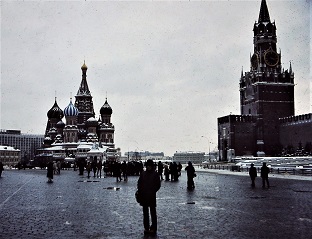
The Kremlin is located in the centre of Moscow and is a historic fortified complex and the place of government for Russia. The word ‘Kremlin’ means ‘fortress’, or a city surrounded by a wall. Although there are many Kremlins in Russia, the word has become associated with the one in Moscow, which has been continuously inhabited since the 2nd century BCE. The Kremlin was the residence of the Tsars until Peter I (1672 - 1725) moved the capital to St Petersburg in 1703. That was to remain the capital until 1918 when it moved back to Moscow. The Kremlin consists of a number of buildings, which include cathedrals and palaces, and a large square, named Red Square which is famous throughout the world. In the 16th Century, it was named Trinity Square and provided access to the main entrance to the Kremlin. In 1650 it was known as Krasnaya Square, which means both beautiful and red. Today Red Square is the main square of Moscow, and its history is inseparably linked with the history of the Kremlin and is known particularly for the May Day parade where the might of the Russian Armed Forces is displayed. The Square contains two of the most famous parts of the Kremlin, St. Basil's Cathedral and Lenin's tomb. St Basil’s Cathedral is actually named the Cathedral of the Intercession, although it is better known as St. Basil's. It was commissioned by Ivan IV (1530-1584) (the Terrible) in 1552 to commemorate the Russian victory over the Tartars. 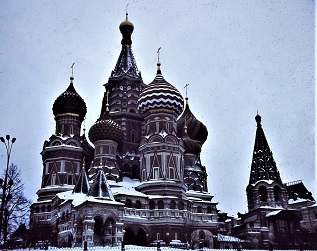 The cathedral consists of eight churches, each having its own cupola or dome, these are situated around one central belfry. Each church was dedicated to the saint on whose feast day, the eight major victories over the Tartars were won. The cathedral has become one of the sites most associated with Moscow but looks different from all viewpoints. At the side of the square is the Mausoleum of Vladimir Lenin (1870-1924), the founder of the Soviet Union. 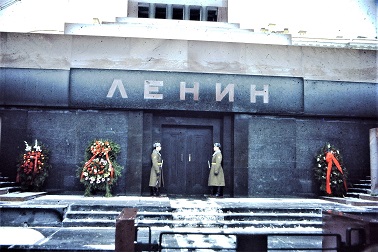 Following his death, in 1924, Lenin was embalmed and placed in a temporary wooden mausoleum. Although Lenin had clearly indicated that he did not want to be immortalized, popular demand led to the temporary structure being replaced in 1929 with a permanent granite Mausoleum, which, over the years has seen thousands of people file past his mummified body. His body is regularly taken to a room underneath where it is on display to be treated and preserved. The Kremlin is surrounded by red brick walls which form an irregular triangle. 2,235 metres in length and 19 metres high it has a depth of up to 6.5 metres thick. Spaced along the wall are 18 towers most of which were built at the end of the 15th century. 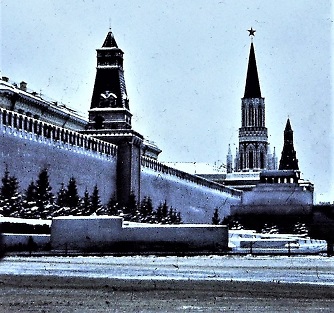 The distinctive jade-green spires of the towers were added in the 17th century and their crowning ruby-red stars in 1937 on the orders of Lenin. The tower leading from Red Square into the Kremlin is the Saviour (Spasskaya) Tower, which is located on the eastern wall of the Kremlin and is the main entrance to the Citadel. 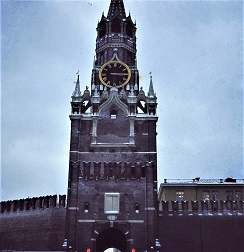 Standing 71 metres (233 feet) high it is the tallest tower of the Kremlin. It was built in 1491 during the reign of Ivan IV. The belfry was added in 1624–25. Standing 71 metres (233 feet) high it is the tallest tower of the Kremlin. It was built in 1491 during the reign of Ivan IV. The belfry was added in 1624–25. The tower contains a clock 6 metres (20 feet) in diameter, the chimes of which are broadcast as a time signal to the country. In Tsarist Russia, the gateway could only be used by heads of state or high officials. On the formation of the Soviet Union, the symbol of the two-headed eagle which used to stand on top of the Tower was replaced with a red star. Behind the Kremlin wall is a mass grave of the Bolsheviks who died during the battle for Moscow in 1917 and the graves of a number of Soviet notables. People buried there include Lenin's wife and his mistress, the writer Gorky and the world's first cosmonaut Yuri Gagarin. It also contains the graves of the Soviet Union's leaders; Stalin, Chernenko, Andropov and Brezhnev. Walking on from the Saviour (Spasskaya) Tower is the Kremlin’s most important and oldest square, which is the Cathedral Square which dates back to the early 14th century. 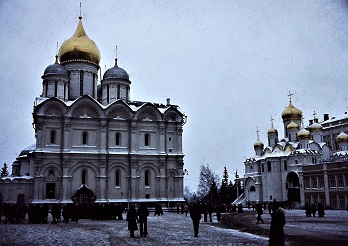 The square contains a number of cathedral and palaces which provide excellent examples of Russian architecture. From the 17th century, the square was covered with sandstone slabs, but in the early 20th century this layer was removed, and the square was asphalted. In 1955 the asphalt was removed, and the stone pavement restored. The oldest and largest church is the Cathedral of the Assumption. 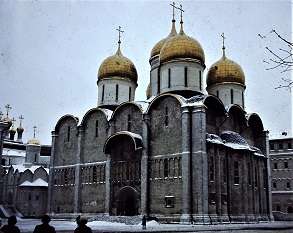 This was commissioned by Ivan the Great to be the main church of Moscow. From the 16th Century until the Bolshevik Revolution in 1917, all of the Russian Grand Princes and Tsars were crowned here. It was the place that Bishops, Metropolitans and Patriarchs were inaugurated and to hold church services before and after military campaigns. It was also the place that the heads of the Russian Orthodox Church were buried. The second-largest cathedral is the Cathedral of St. Michael the Archangel. 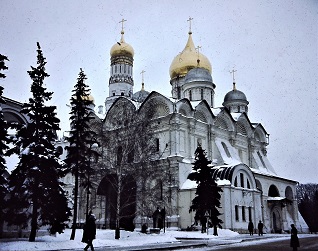 The Cathedral of the Annunciation served as the private chapel of the Tsars. It was built in 1484-1489 on the foundations of a much earlier and more modest church and has been damaged, repaired, enlarged, and altered on numerous occasions. 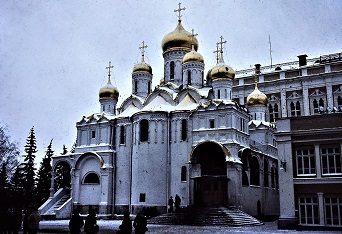 The Ivan the Great Bell Tower was built for the Assumption, Archangel and Annunciation Cathedrals, as they do not have their own belfries. There has been a bell tower on this site since 1329 with a new bell tower being erected on the foundation of the old tower between 1505 and 1508. 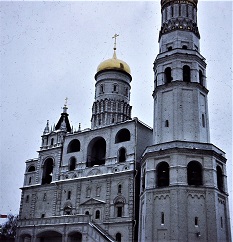 Originally the tower had 2 belfries on different levels, but in 1600 it was raised to its present height of 266 ft. In addition to the main belfry, there is the smaller domed Bono Tower, and the steeple tower, both of which were added to the original 16th Century structure. The whole structure contains 24 bells. The belfry was used as a watchtower for the Kremlin as it provides a view of some 20 miles. It is said to mark the geographic centre of Moscow. Originally the tower had 2 belfries on different levels, but in 1600 it was raised to its present height of 266 ft. In addition to the main belfry, there is the smaller domed Bono Tower, and the steeple tower, both of which were added to the original 16th Century structure. The whole structure contains 24 bells. The belfry was used as a watchtower for the Kremlin as it provides a view of some 20 miles. It is said to mark the geographic centre of Moscow.At the foot of the Ivan the Great Bell Tower is The Tsar's Bell. This was commissioned in 1734 by Tsarina Anna (1693-1740) and was to be the biggest and clearest sounding bell in the world. Weighing over 200 tons, it stands over 6 meters high and features richly decorated reliefs depicting saints and the Empress herself. However, in 1737, during a major fire, the bell suffered serious damage when during the attempt to put out the fire, cold water was poured onto the heated metal, causing a large 11-ton piece to break off. As a result, the bell could never be rung. In 1836, the Tsar Bell was unearthed and placed in its current location in the Kremlin. Although it never worked, it is now a symbol of Russia's cultural heritage and the ambitious projects of its imperial era. . 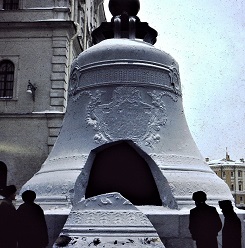 Also to be seen in this area is the Tzar’s Cannon. Built in 1586 by Tsar Fyodor I (1557-1598), to protect the Kremlin it's considered to be the largest cannon in the world. Sixteen feet in length, it weighs 85,000 pounds. 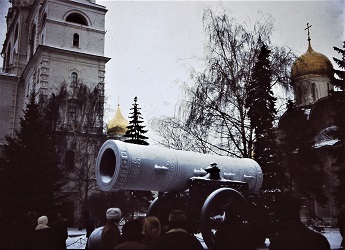 Other buildings in the vicinity include The Palace of Facets, which is the oldest surviving secular building in Moscow. It was built between 1487 and 1491 for Ivan the Great. The Terem Palace was originally constructed between 1499 and 1508 but added to in 1635 / 36 and was the Imperial residence. The top floor was the private chambers, where, during the 17th century, the female members of the Romanov family lived in seclusion. The Grand Kremlin Palace was commissioned by Tsar Nicholas I (1796-1855) in 1838 as the new imperial residence. This is the largest structure in the Kremlin and was designed to link the older Terem Palace and Palace of Facets, with its new reception halls and private Imperial Apartments. Nowadays, the whole Grand Kremlin Palace’s complex houses the rooms used by the President of the Russian Federation. |
|
|
|
|
|||
All Photographs were taken by and are copyright of Ron Gatepain
| Site Map |